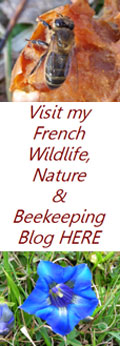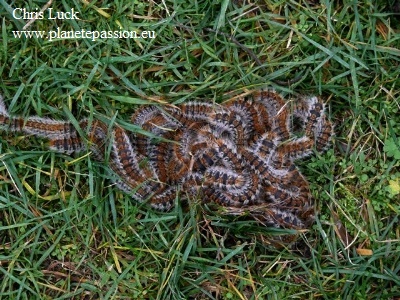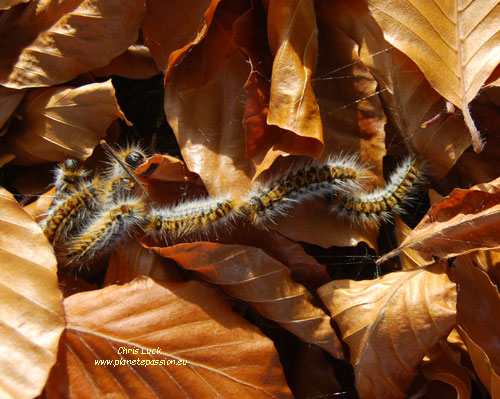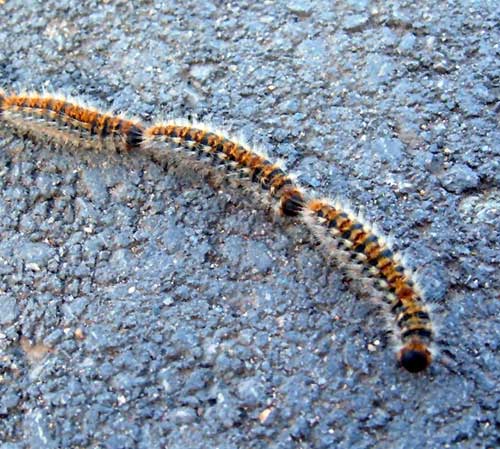Pine processionary moth France
|
|
|||
|---|---|---|---|---|
|
Pine processionary moth - Thaumetopoea pityocampa - Processionnaire du pin
|
||||
|
The moth of Thaumetopoea pityocampa, is fairly small and a non descript drab greyish brown, generally nocturnal and unlikely to be noticed, normally it only lives for one night so it needs to go about its business quickly. It lays its eggs in summer, generally fairly high up in most species of pine trees and although there is evidence that in some cases types of fir are used, all other conifers are avoided. The young caterpillars make their initial nest and then in autumn they make the larger ones which are clearly visible, this is where they spend the winter, often in colonies of several hundreds. These webs are amazingly dense, virtually impenetrable and provide not only a safe place for the caterpillars but also an environment that is often several degrees warmer than the surroundings throughout the winter period, all clever stuff! Like the adult moth, the caterpillars are nocturnal, forcing their way out of the nest at night to forage on the pine needles where they can cause a fair amount of damage, this will obviously weaken the tree but is unlikely to actually cause its death, they then return to the nest before daylight arrives. |
||||
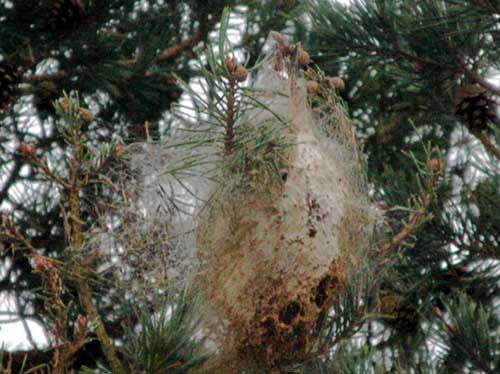 |
||||
|
Photo above.
Pine processionary moth
nest. 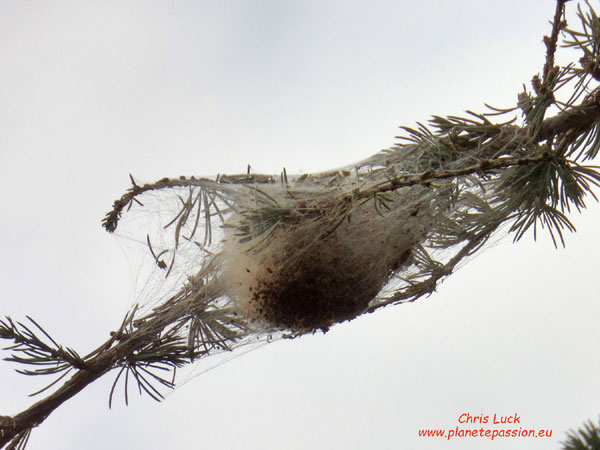 Photo above - Pine processionary moth nest in a Fir tree. |
||||
|
In winter or spring, anytime from December, (or even November), until May depending on weather conditions the caterpillars leave the trees and go down to the ground, this is when we will see them forming their long nose to tail processions as they make their way to find a place in the soil to pupate, the period of pupation can last a couple of months or several years. They actually touch each other to make a long chain, hence the common name of Pine processionary moth, this is important to remember as there are other caterpillars which follow each other in lines but do not touch (there is also another Processionary caterpillar, the Oak Processionary, but this is only active at night and of no concern).
|
||||
|
Photos above.
Pine processionary moth caterpillars. |
||||
|
The caterpillars have orange brown backs with bluish grey bands and bluish grey protrusions in pairs at each segment, these protrusions have little bunches of hairs “growing” from them and it is these “hairs” that can be a danger. These irritant hairs contain a highly allergenic protein which in humans can cause reactions ranging from mild itching to anaphylactic shock, all contact with sensitive skin regions, your mouth, nose or eyes should be avoided. Show caution with your animals, dogs in particular may sniff them and this should be avoided at all cost, Necrosis of the tongue has been observed in some domestic animals and severe swelling may occur causing breathing difficulties. This may all sound a bit “shock and horror”, but it really isn’t that bad as they are easily seen in their long chains, it is usually only necessary to be on the look out from December until May and they will only be in proximity to pine or fir trees, so no need to get too worked up about it. However it is possible during mild autumns and winters that development will be rapid and descent from the trees could take place as early as November. If, on the other hand, you have them in your garden you should perhaps consider having the trees removed. Ideally this would be in late summer when any caterpillars are too small to be a danger and any birds should have finished nesting. They are widespread in the southern half of France and have been progressing northwards with the climate changes that are taking place, having now extended their range to north of the Loire and are only a matter of 20 or so kilometres away from Paris. Interestingly the caterpillars die at a temperature below -16°C, and their nocturnal feeding is conditioned by the succession of temperatures higher than 9°C in the nest during the day and air temperatures higher than 0°C the next night, so with the milder conditions that we are now experiencing overall they are having a “boom time”. There are of course a large number of “hairy” caterpillars and web forming caterpillars. All hairy caterpillars can cause irritation to some degree, but before you go killing every caterpillar in sight, these other caterpillars are not a danger and I would encourage you to leave them alone, they are often the caterpillars of some of our more colourful butterflies. It only takes a moment these days to take a photograph to obtain identification which you can do via our FB Page HERE. Natural predators are: Crested tits that will eat the eggs and very young caterpillars. Cuckoos that will eat the caterpillars. Hoopoes that will eat the pupa from the ground and most bats that will eat the moths.
See also Pine
processionary moth and Napoleon 3rd of France
HERE
|
||||
|
|
||||
.jpg)


